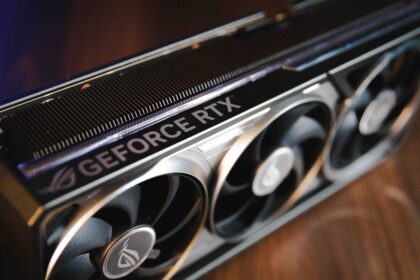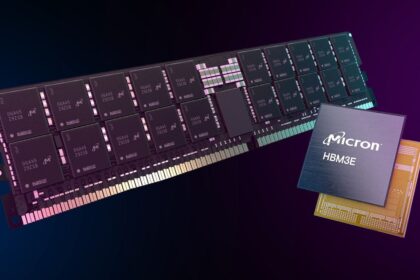The race to optimize transistors is in full swing, as chip manufacturers push for more performance while improving energy efficiency. Over the decades, transistor technology has evolved significantly, and now Intel is preparing to introduce a major innovation: the RibbonFET transistor. This breakthrough promises a substantial leap forward in computing power and efficiency.
To gain deeper insight into Intel’s proprietary technology, Reporter spoke exclusively with Yuri Daglian, an application engineer at Intel. In the interview, he explained how RibbonFET works and what it means for the future of semiconductor manufacturing.
What is RibbonFet?
The RibbonFET transistor is Intel’s implementation of the Gate-All-Around (GAA) industry standard. According to Yuri Daglian, an application engineer at Intel Brazil, semiconductor technology has evolved significantly over the years.
“In the past, semiconductors were two-dimensional,” Yuri explains. “At one point, Intel introduced a major innovation with FinFET transistors, which brought three-dimensional design to the industry.”
He further elaborates that the 3D transistor structure—comprising the gate, channel, and drain—allows for more consistent and controllable current flow, leading to greater efficiency than traditional 2D transistors.
With GAA (Gate-All-Around) technology, the transistor takes another leap forward. The gate now fully surrounds the channel on all four sides, offering even better current control, improved efficiency, and potentially higher performance for future processors.
“And more than that, Ribbonfet architecture is more compact than a finfet transistor. The nanometric ribbons (ribbon) that represent channel are stacked vertically and with that I can have a slightly more compact structure and a larger transistor density, ”he adds.
The RibbonFET architecture marks Intel’s first new transistor design in 14 years, following the launch of FinFET in 2011. This innovation represents a major technological leap, with Intel estimating a 15% increase in performance per watt compared to previous designs. This improvement could lead to more power-efficient and higher-performing processors, setting the stage for the next generation of computing.
Benefits and Advantages of RibbonFet Transistors
The RibbonFET transistor’s performance boost is one of its biggest selling points. A 15% increase in efficiency means a PC could deliver higher performance with the same power consumption—for example, 15% more FPS in a game—or maintain the same performance while extending battery life. As Yuri Daglian explains, if a laptop previously lasted 10 hours on a charge, it could now reach 11.5 hours thanks to this innovation.
Another key advantage is higher transistor density compared to FinFET. The RibbonFET design allows for more transistors in the same area, leading to better performance in processors and other computing applications. More transistors mean faster, more powerful chips, pushing the boundaries of efficiency and speed in modern computing.
Disadvantages and Challenges of RibbonFet Transistors
Despite its promising advancements, RibbonFET technology comes with challenges. One of the biggest hurdles is vertically stacking the transistor channels. Yuri Daglian compares it to constructing a skyscraper: “Just like a building, you need a solid foundation and precise calculations, or it could collapse.” However, instead of meters, Intel is working with nanometers, making the process extremely delicate and complex.
“Costs are also high because we need to use the most modern lithography manufacturing machines. Lithography, as the name implies, is spelling by light. In this case, by ultraviolet light. So when we have an extreme ultraviolet technology, I need machines that often cost more than $ 100 million, a single unit, and it sometimes has the size of a popular home, for example ” , he adds.
Additionally, competition is fierce. Industry giants like Samsung and TSMC are also developing Gate-All-Around (GAA) transistor architectures, pushing Intel to innovate rapidly in the semiconductor race.
Application scenarios
RibbonFET transistors are expected to revolutionize multiple computing segments, including high-performance computing (HPC), mobile devices, and the Internet of Things (IoT). According to Yuri Daglian, the advantages of this technology make it likely that “all high-performance semiconductors will eventually transition from FinFET to RibbonFET.”
“This is the trend. Be semiconductors for high performance computing, supercomputers, whether applications for artificial intelligence, GPUS or NPUS, for example. Or when we think of processors for notebooks, desktops, cell phones, or even IoT, all these applications will benefit from more efficient transistors or deliver more performance with the same consumption. ”
However, not all industries will adopt this innovation. Some sectors, like telecommunications, still rely on older semiconductor nodes because the performance gains don’t justify the higher manufacturing costs. In these cases, sticking with existing technology remains the more practical and economical choice.
Practical examples
Intel’s RibbonFET transistors have yet to make their way into commercial products. According to Intel Brasil’s representative, this technology was initially planned for chips manufactured on the Intel 20A process, which was later canceled in favor of the more advanced Intel 18A process—a shift that happened “faster than expected.”
The lithography process for Intel 18A is now complete. It awaits integration into upcoming products, such as the Panther Lake mobile processors, which are expected to launch in the second half of 2025.
Since RibbonFET transistors have yet to be tested in real-world products, their practical impact remains uncertain. However, they are expected to deliver higher performance, improved energy efficiency, and lower temperatures than previous technologies like FinFET.
3D encapsulation
With the shift from monolithic chips to chiplet architectures, 3D packaging has taken over the CPU and GPU market. Intel has embraced this trend with Foveros packaging technology, which enables the stacking of multiple chip dies.
Alongside 3D die stacking, RibbonFET transistors will benefit from another Intel innovation: PowerVia. This new power delivery method restructures how power and signal connections interact within a chip.
As transistors shrink, traditional power and signal routing become less efficient. PowerVia separates these layers—placing power delivery on the bottom and signal pathways on top—to reduce interference and improve energy efficiency.
According to Intel Brasil’s Yuri Daglian, PowerVia increases transistor density by 5-10% and boosts performance by 4% at the same power consumption. Combined with RibbonFET transistors, this could lead to an overall efficiency gain of 20-30%, making next-gen chips faster and more power-efficient.
Conclusion
As mentioned earlier, RibbonFET transistors are set to debut with Intel’s 18A lithography in the upcoming Panther Lake generation, which is expected to power the Intel Core Ultra 300 series for notebooks. This launch represents a significant technological leap, offering higher performance per watt and improved efficiency.
With the industry racing to create more powerful and energy-efficient chips, GAA (Gate-All-Around) transistors are expected to see wider adoption starting this year. However, since these technologies are still developing, the final specifications may change before the official market release.











